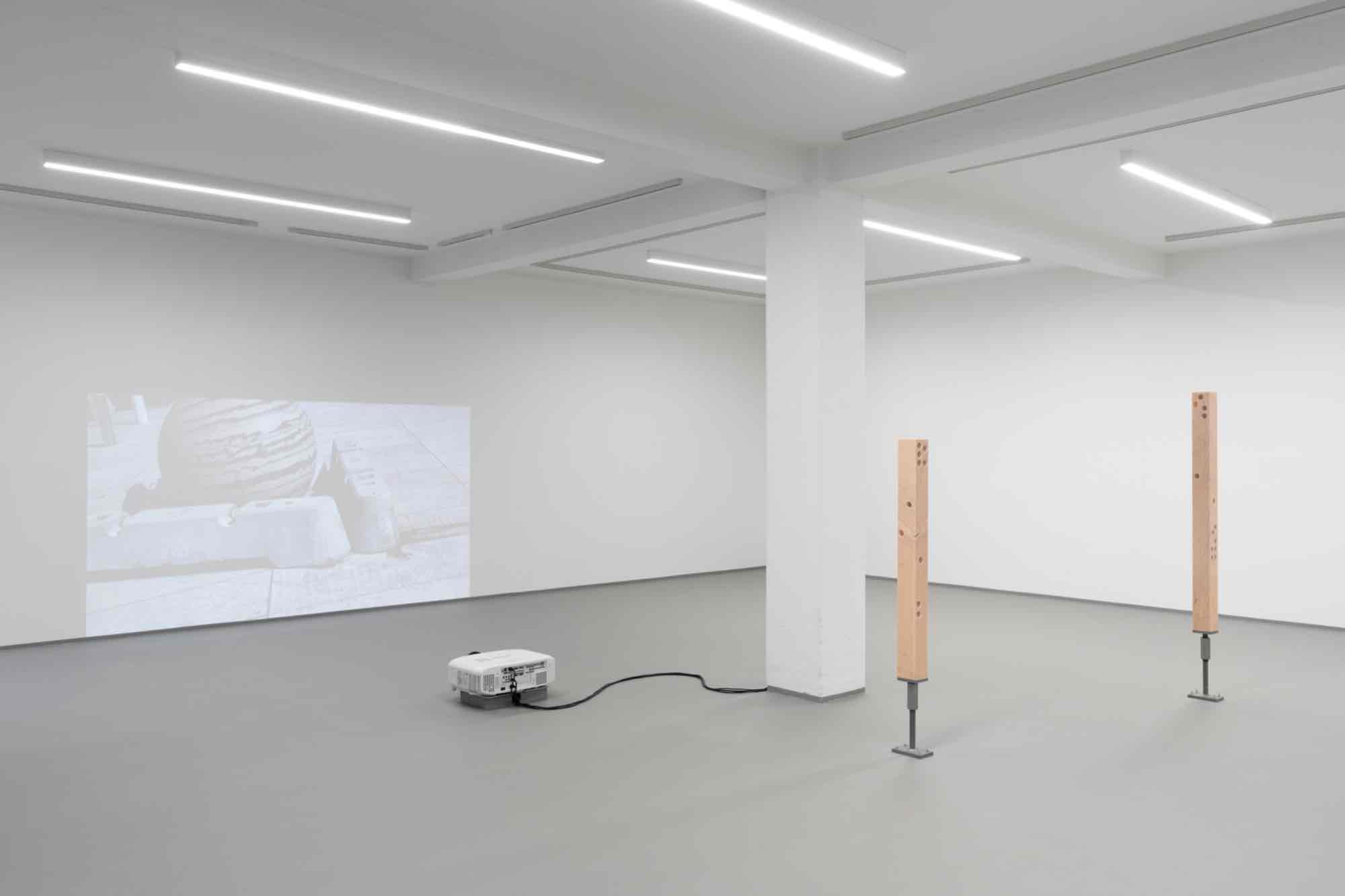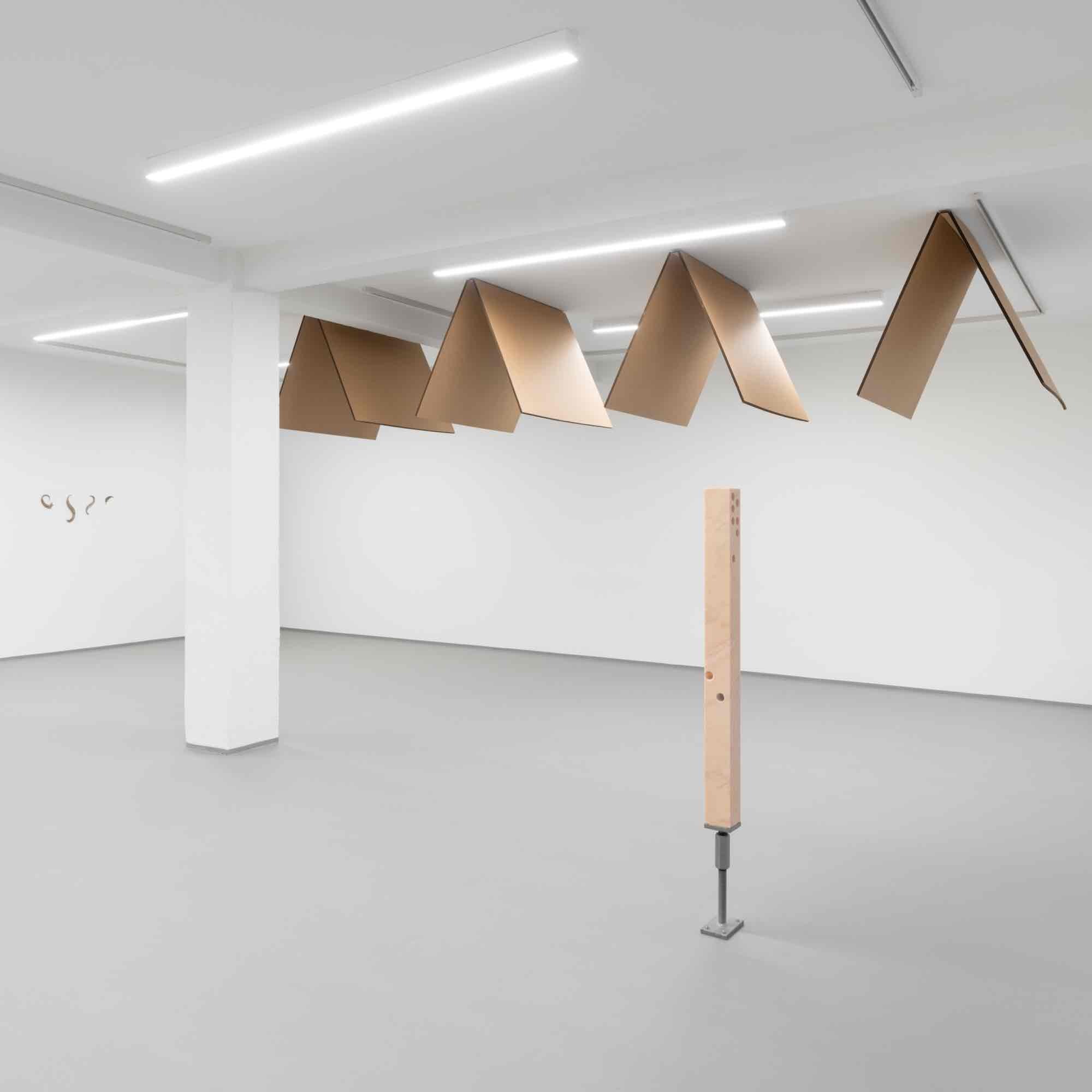Julie Falk
Antiform
24 Feb - 05 May 2024
The arrested pace of the hospitalized body—in bed as if “incarcerated” and working from confinement—is the baseline of Julie Falk’s (DK, 1991) recent sculptural and filmic works.
In her first large-scale solo exhibition, Antiform, Falk takes discarded bodies as a point of departure—from bronze casts of hair cut from hospital-prescribed wigs to enlargements of cardboard tubes from used fireworks, giant phallic figures that seem over-run, deformed, and embrittled, resting on the floor in the exhibition’s front space. Falk points to the bodily displacement of the artist herself, working away from the studio, as an inverse or anti-position, operating at odds, and meanwhile collecting scrap materials—forms that are discarded, abject, or thrown from use or even from art: Antiforms.
At the exhibition’s entrance, we meet a woman (the artist), captured in the looping video piece Détournement. Backed by a roaring rumble, she walks in slow-motion broken circles on the hospital helipad of Rigshospitalet, looking away, outward, as if trying to escape the gravitational powers of the healthcare system. As its opposite, in the exhibition’s back space, the new video piece Crip Time loops aggressive pendulum movements around a marble sculpture by Alicja Kwade near Rigshospitalet. Gazing towards the decorative sculptural sphere, the piece turns into a metaphor of the planetary centripetal force that keeps the ill body in close range of its medical center, exposing the system of care as also one of control and custody.
A new series of body-sized, rosy-skinned marble slabs are balancing, tall and thin. The sculptures are perforated, as if after a biopsy, pointing at how we as bodies ultimately always share matter, as the title says I’m Not One. With a nod to the 1960s situationist movement, Falk turns around existing systems or architecture. In Inhabit Everywhere, cardboard sculptures hang as roofs or stand gaping, upside-down on the floor. The roof, the ultimate domestic shield, is here abstracted, soft, and frail, as if asking: where is the protection?
In her first large-scale solo exhibition, Antiform, Falk takes discarded bodies as a point of departure—from bronze casts of hair cut from hospital-prescribed wigs to enlargements of cardboard tubes from used fireworks, giant phallic figures that seem over-run, deformed, and embrittled, resting on the floor in the exhibition’s front space. Falk points to the bodily displacement of the artist herself, working away from the studio, as an inverse or anti-position, operating at odds, and meanwhile collecting scrap materials—forms that are discarded, abject, or thrown from use or even from art: Antiforms.
At the exhibition’s entrance, we meet a woman (the artist), captured in the looping video piece Détournement. Backed by a roaring rumble, she walks in slow-motion broken circles on the hospital helipad of Rigshospitalet, looking away, outward, as if trying to escape the gravitational powers of the healthcare system. As its opposite, in the exhibition’s back space, the new video piece Crip Time loops aggressive pendulum movements around a marble sculpture by Alicja Kwade near Rigshospitalet. Gazing towards the decorative sculptural sphere, the piece turns into a metaphor of the planetary centripetal force that keeps the ill body in close range of its medical center, exposing the system of care as also one of control and custody.
A new series of body-sized, rosy-skinned marble slabs are balancing, tall and thin. The sculptures are perforated, as if after a biopsy, pointing at how we as bodies ultimately always share matter, as the title says I’m Not One. With a nod to the 1960s situationist movement, Falk turns around existing systems or architecture. In Inhabit Everywhere, cardboard sculptures hang as roofs or stand gaping, upside-down on the floor. The roof, the ultimate domestic shield, is here abstracted, soft, and frail, as if asking: where is the protection?








